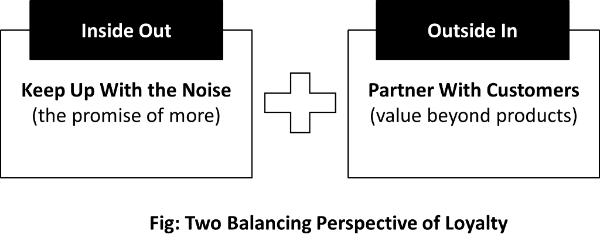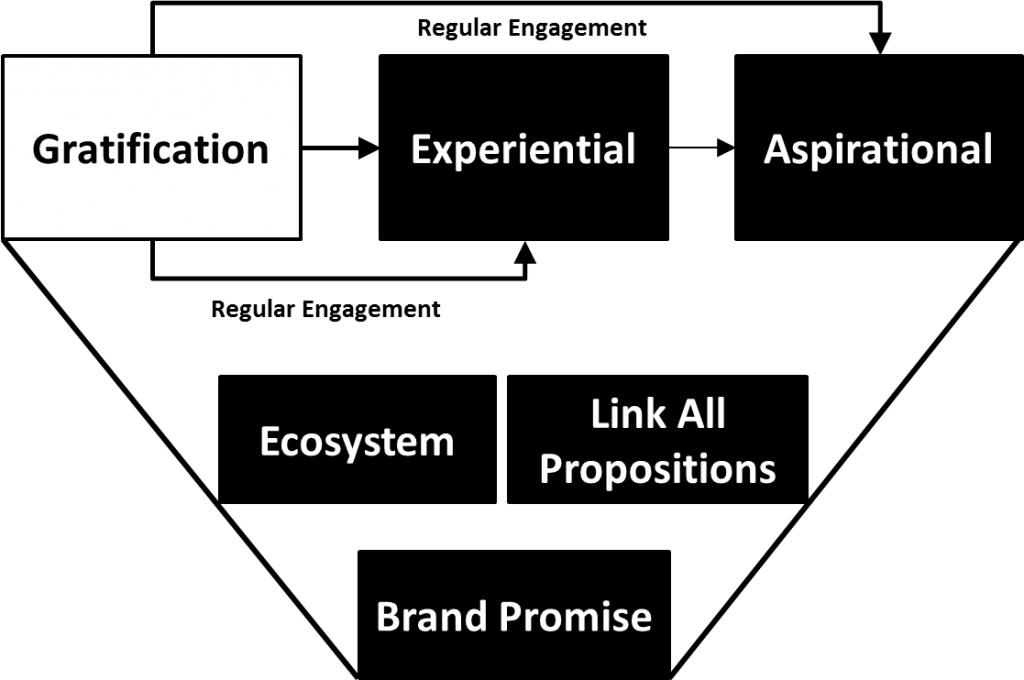Let me lay out this exciting concept from my book “Connected!”. This is the 3-Tier Model of Customer Loyalty Rewards. I’ll show you how to build programs that are NOT just based on discounts and promotions. We’ll see how to connect with customers on an emotional level and appeal to their motivations and aspirations.
Let’s dig right in!
The 3-Tier Model of Customer Loyalty
Loyalty rewards programs are everywhere. According to a study by COLLOQUY (see ref 4 in the book), the average household in the US has over 29 loyalty program memberships but actively uses only 44% of these. The study also pointed out that 58% of customers don’t even bother to participate and are less engaged members.
These statistics alone show us that our concept of loyalty rewards needs to be revisited and evolved.
Lets start with this concept I wrote about in the book – the 2 balancing perspectives of loyalty:

If you think about it, our loyalty rewards programs have traditionally been about the promise of more. And that’s perfectly fine. We do have to appeal to basic instincts of our customers. But as our original programs have become commoditized, there is potential to do much more.
Let’s quickly recap a list of methods that fall under the promise of more:
- More ways to earn points
- Ease of redeeming points
- Quality of customer service
- Expansive rewards catalog
- More value for points or fees
These are time tested models, but they are losing their shine. So we need to get to the next level of loyalty by offering value beyond products.
Value beyond products – is that even possible?
Yes, it is. And great brands have already employed parts of this concept so this is not entirely new when it comes to executing it.
I designed the 3-tiered loyalty rewards model to re-examine the popular concept of loyalty so that it becomes a strategic discussion, not just a supporting activity. Here’s the 3-tiered model of loyalty to address the Outside-In – aka customer centric – perspective of loyalty programs. The 3 tiers are aligned to the kinds of value we can provide our customers.

Tier 1 of the model elevates the cash and discount model to create experiences and aspirations for customers. The reason to do that is simple. We need a way to align the brand promise with the way customers interact with us. Points and discounts are a common way to “reward” customers.
It is indeed gratifying to see the total amount on the bill magically shed cents and dollars at the cash counter. All that is needed is to sign up for a loyalty rewards program. However, it is increasingly obvious that points and discounts are becoming table stakes. A 2015 brand loyalty study indicated that 76% of Americans think that loyalty programs are part of their relationship with brands (see ref 6). Heartening as that number seems, the same study (see ref 6) also pointed out that 44% of surveyed customers believe that it’ll be easy to switch one rewards program with another, and 67% will change the brands they purchase to maximize their benefits from transactions.
This implies that we are operating at a much commoditized level with our loyalty programs. The issue is broader than just points and rewards. Instead this is a strategic topic about the differentiation we enjoy in the customers’ minds.
The next level up in the loyalty is the experiential level. This level helps customers feel differentiated and exclusive. It provides rewards that are less about money, and more about exclusivity and experiences. At this level, the program trades some portion of the immediate gratification value towards bragging and feel good rights. Examples include free personalized valet parking for your next date, the reserved corner table for dinner at an exclusive restaurant, early access to concert tickets, the red carpet to boarding the flight, etc. One can probably put a monetary value to these rewards, but the value delivered is way beyond money.
The final level in Tier 1 is about aspirations. This level of the loyalty model further helps customers positively make choices in our favor given multiple other options. This level is fantastic to get customers in a state of working with you on a long term goal that they aspire or journey towards. Aspirational loyalty is linked to and emerges from the experiential level. The primary difference stems from creating a longer term motivation for customers that cannot just be measured in monetary terms. At this level the program will structure regular redemptions but gear itself towards setting a higher goal as well. Example include building towards a family trip to the Bahamas, saving for the dream home, sending a child to college, status in the community as “The Social Citizen” etc. Fitness is another global theme. Who doesn’t aspire to this noble but challenging goal?
I said before that companies have tried this before and succeeded. Think about your favorite airline loyalty rewards as a prominent example.
Tier 2 in the loyalty rewards model is meant to leverage the power of an ecosystem of players which may be from many different industries. Every business has channels they reach customers on. However, the concept of ecosystems tries to understand the complementary or supplementary needs that our products are a part of. And that means striking up partnerships with other businesses that lead to our business. For example, a clothing retailer may partner with an events company, or with a firm offering outdoor adventures. A casual dining restaurant may partner with fitness centers or local retailers to deliver an all-in-one package. American Express recently made Uber rides possible and rewarded through its mobile app. Technology make all of this possible today. And if we don’t think and act strategically to build connections between different value propositions, someone else will beat us to it. Tier 2 of loyalty rewards model is all about putting the customer, not our products, at the center of the universe.
Finally, Tier 3 brings the core brand promise at the forefront of the loyalty rewards discussion so that every action reinforces the emotional and physical contract we intend to establish with our customers. We often think of how seamless it must be for customers to sign up and redeem their points. But is seamless the right way for us to build true loyalty? Should we instead keep loyalty prominent but make the actual transactions seamless.
- First there are the differentiation aspects such as being the first to come to mind when customers not only think of the core products, but also complementary activities and emotions (as in the ecosystem we build). The question to ask is whether our loyalty program a is part of their decision making process when customers are looking for our products or evaluating their overall need which our product is a part of. For example Panera Bread recently moved to being 100% clean food with no artificial ingredients and preservatives. This development gives them the foundation to develop other emotional connections.
- Second, we must think of how easy it is for consumers to track and redeem – do they know how their program works, how do the rewards link to our brand, what do customers feel and how they talk about our service. Order ahead and pick up services from Starbucks are a great example of how they remove friction from the process. The emergence of Apple Pay is another example – in addition to higher security, mobile payment is seamless and convenient. Amazon Prime is another example of friction being demolished because multiple products fall under the Prime umbrella.
The entire industry is ripe with examples of how friction is being removed. The major difference between the approaches take by companies is this: do we look inside-out from our products perspective (e.g. Panera), or do we look outside-in to build an ecosystem (e.g. American Express Plenti). Both approaches need to be considered and have their own challenges. The ecosystem based approach builds additional competitive barriers and additional customer engagement avenues that a single company cannot easily build.
Finally, we must connect emotional connections with physical experiences so customers directly experience our brand with the promise it projects. For example, if customers buy outfits for an outdoor adventure, are they forgotten after the purchase? Think of Panera for a minute. How does it reinforce the 100% clean food brand with physical experiences after the purchase. The ecosystems of external companies we are beginning to create in a connected world offer us new avenues to reinforce our brand promise. On the flip side, fear of how a partner may negatively impact our brand through adverse experiences is very real. But it’s a risk we must take on and mitigate if we wish to become relevant in a connected world.
All three tiers of the loyalty rewards model are interconnected, and must be considered together as we set about creating a strong customer engagement and loyalty program. In a connected, digital world, our business models are being transformed every day in unexpected ways. The 3-tier model of loyalty helps us create lasting relationships, by thinking beyond points and miles.
While you are taking a break, spend some time to outline how your loyalty rewards models are doing, and who you can partner with to move to experiential and aspirational levels. Also, think about how your brand promise is being reflected in actual customer interactions.
